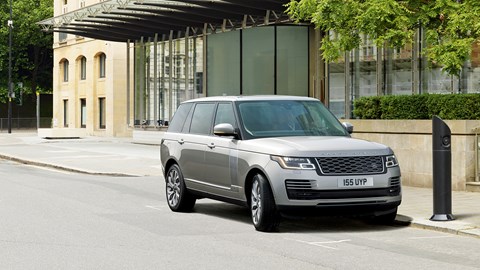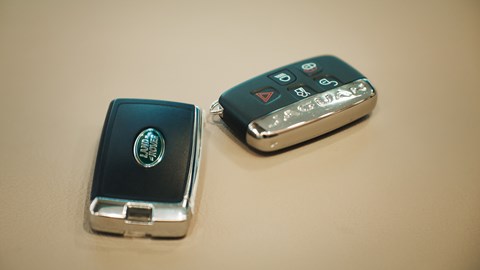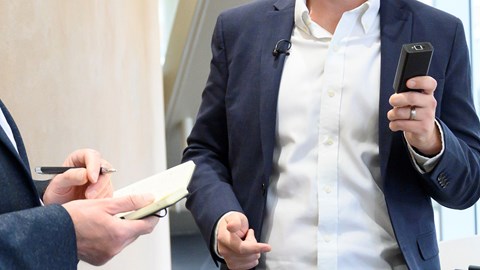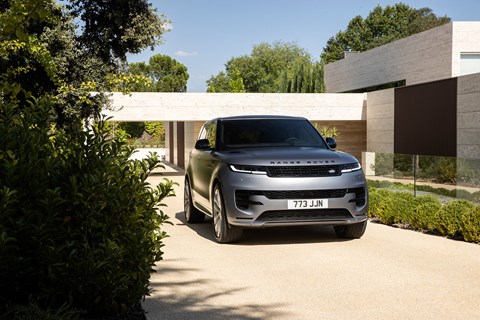► New security measures recommended
► Revealed in a letter to an owner
► Advice includes batteries and Faraday pouches
Jaguar Land Rover has dispatched a fresh round of security advice for some of its older cars, with free, up-rated smart key fob batteries on offer for qualifying owners, one has revealed.
Outlined in a letter to the owner, the ‘sleeping’ batteries have a built-in motion sensor that will put the key into a sleep mode after three minutes of static inactivity.
JLR says the batteries – which are available on a first come, first serve basis – are to provide an extra layer of protection against relay theft – a method by which thieves hijack the signal between a car and its key to unlock the doors.
In addition to the new batteries, JLR is also supplying qualifying owners with signal-blocking Faraday pouches for keys to be stored in safely overnight. According to the manufacturer, the Faraday pouches are a sort of stop-gap to offer as much protection against relay theft as possible, before a fresh software update to prevent BCM theft – a hijack of the car’s body control module – arrives later this year.
The software update that will bring the older cars’ BCM protection in line with that of the newer crop, Jaguar Land Rover says.

In response to the letter, a JLR spokesperson told CAR: ‘The UK vehicle theft issue is affecting all manufacturers. We understand how deeply distressing being a victim of car crime is, so we have invested £15m to update more than 216,000 previous-generation and out of warranty vehicles so they have the highest levels of security – revisiting older models is unprecedented in the automotive industry.
‘Going back to as far as 2016 vehicles, our engineers are developing software compatible with older systems and hardware, and we have provided physical theft prevention tools as an interim measure.
‘We will continue working to reduce the scale and impact of vehicle crime and through our close collaboration with police, we work to stay ahead of any emerging methods.’
JLR has also pledged an additional £1m to bolster proactive policing efforts. The firm says it wants to support several police forces with extra resources, plus a dedicated intel group to help bring down theft rates in certain hotspots.
CAR was invited to JLR’s base earlier this year, to discuss the ways in which the brand has tried to combat high theft rates, and what the plans are for the future. See below to read more on JLR’s anti-theft strategy.
Jaguar Land Rover has outlined the steps it’s taking to improve security measures on its vehicles, including the Range Rover line-up and Land Rover Defender, with both new and older models eligible for an update.
The manufacturer has come under increased scrutiny in recent months over how many of its cars are stolen – and many insurance companies are refusing to offer cover owing to the alleged ease of entry. It’s a sign of the growing problems with automotive cybersecurity faced by all manufacturers.
The best security products to defeat criminals
Land Rover hit back this week, disclosing proof that the Range Rover is not the most stolen car in the UK, nor do any JLR models place within the top three. According to JLR, the risk of theft is significantly higher for its older models – specifically those built between 2016 and 2018, and some built in 2019. But, conversely, theft rates on newer vehicles have been significantly lower, its data show.
Just 0.08% of the latest generation of Range Rovers sold have been stolen in the UK since the model was launched just over two years ago – that’s 11 cars. For the Range Rover Sport, 0.1% of vehicles sold in the UK have been stolen (15) and 0.3% of Land Rover Defenders (134 cars).
Despite the falling figures, JLR has made a huge investment into new security kit for its cars while working with police forces across the country to help tackle car theft on a national scale. We spoke to the teams responsible for security to find out what’s being done at Gaydon to make their cars theft-proof.
Ultra-wide band radar technology
Keyless locking systems have become a known weak point in car security systems. Previous generations of the Range Rover and Range Rover Sport (especially those built between 2016 and 2018) were susceptible to relay car theft.
This method involves two thieves using signal-hijacking equipment to replicate the signal from a car’s key to open the car door and even start the engine – all while the key remains inside the house.

However, since 2018, JLR has employed Ultra-Wide Band radar technology in its keys and vehicles to detect just how close the key is to the car before allowing it to open. To unlock the doors, the key must now be right next to the car before its validity is recognised.
According to chief electrical engineer Stewart Moore, Ultra-Wide Band keys have effectively ‘killed off’ relay hackings on JLR cars as no one has yet figured out how to overcome the technology.
BCM hack technology
As relay car thefts have waned, body control module (BCM) hacking cases have risen to take their place. Once a car has been unlocked, thieves are plugging a BCM hacking device – street valued at around £25,000 – into the on-board diagnostics (OBDII) port then programming a key ID into the body controller to start the vehicle.

‘This is what my team has spent the last two or three years trying to address,’ Moore added. ‘We’ve overcome it with a body module control software update. There’s now a form of customer authorisation required before key programming is allowed to take place.’
According to Moore, it can be authorised by one of two ways. Either the car can be put into service mode via the control app or there is a valid key detected inside the car to soft unlock the body control module. ‘This has been the game changer from our perspective. This is why the theft rate on new Range Rovers and the Range Rover Sport is as low as it has been as, to date, thieves still haven’t found a way around it.’
Car key updates
Along with the introduction of ultra-wide band technology, JLR has updated its vehicle keys and remote security systems with additional locking capabilities to curb opportunistic thefts when the car is particularly vulnerable. Say, while in a car park or at a petrol station.
On newer cars like the Range Rover Sport (below), if you press the lock button once, the car will single lock to activate the perimeter alarm and turn on the intrusion sensors. In this mode, if the car window is smashed or the door opened, the alarm will fire. If the button is pressed twice in three seconds, the car will double-lock, meaning that if a window is smashed to open the door from the inside, it won’t unlock.

New Range Rovers will receive walk-away locking technology that locks the car automatically once it detects the key has left a 2.5-metre perimeter. There’s also a new security feature in the control remote app known as Guardian Mode that will notify the owner if their car is tampered with in any way when parked up.
What about older Range Rovers?
JLR is using risk data provided by insurance partners to identify which the most high-risk models are and where they’re located. These are the vehicles that have been targeted for the software updates first, though the manufacturer is going back to 2016 models to cover as many customers as possible.
Lee Walton, head of JLR’s Vehicle Theft Reduction Group, said: ‘Going back to 2016 model year, they’re cars that are coming up to 10 years old and have been out of warranty for six and seven years. It’s a huge group of cars to go over, but shows the focus that we’re putting into making these cars resilient for our clients.We want them to be secure, we want them to have a great ownership experience and we want them to get competitive insurance.’
According to Walton, the update only takes 20 minutes at a main dealer.
What are the older cars receiving?
Vehicles too old to benefit from ultra-wide band technology are being retrofitted with a dormant additional GPS tracker called Tracker Retrieve that’s available on the aftermarket as part of a five-year subscription package. JLR is also working with consumers to install the best aftermarket immobilisers, but Lee Walton suggested that consumers should pick their immobiliser based on advice from their insurer as different firms have unique preferences on immobilisers to help benefit premiums.
What about the future for JLR cars’ security?
JLR has been working with the police and government to outlaw the key programming tools that thieves use to steal cars. Historically, such devices have been considered part of the automotive locksmithing toolbox, but JLR has worked to pass legislation that recognises them as tools for theft.
The Criminal Justice Bill that proposes these changes is currently making its way through Parliament and is at the end of the committee stages, ready for the House of Lords.
The manufacturer is also investing heavily in additional port security while working in conjunction with other law enforcement teams, analysing each car theft case to identify where measures can improve.